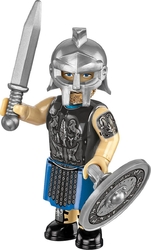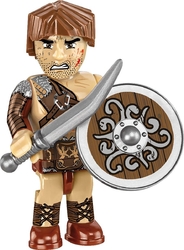Kit model of the famous imperial gladiator school Ludus Magnus. The assembled model has a training yard with a balcony and an opening gate to the arena. The kit includes many details such as a practice target, a bench, wine amphorae, weapons and shields. Also included in the package is a lanista figure of the administrator of the imperial school and two gladiators.
Show more
0 %
(0 Ranking)
1 210 Kč
pcs
Add to Cart
In stock - ready to ship (4 pcs)
| List Number: | COBI-20070 |
| EAN: | 5902251200701 |
| Warranty: | 24 months |
| Manufacturer: | COBI |
| Loyalty Points: | 8 |
| Price excluding VAT: | 999,60 Kč |
Description
Parametres
Files and Links
Discussion
Reviews

You know that:
- Many gladiator schools were established in the Roman Empire, but only four of them were under the direct administration of the emperor himself, represented by an official lanista.
- When Lanista took office, he had to swear that he would submit his whole life to the school and was obliged to live in the school.
- The official managed absolutely everything from the recruitment of new gladiators, food, medical care and armaments.
- The lanistas of ancient Rome were recognized and respected high officials of the emperor with a high social status.
- The name of the wrestler originated from the short Roman sword gladius and therefore gladiator.
- Most gladiators were slaves, prisoners of war, but also highly paid professionals.
- There was a strict hierarchy among the wrestlers. After the first match, the gladiator could use the title Veteranus, the good fighters the title Secendus palus, and only the best could be addressed as Primus palus.
- The first written mention of matches dates from 264 BC, when a match was held during the funeral ceremony of the Roman Decimus Perus as a demonstration of Roman virtue.
- Over the years, wrestling became a means of public entertainment and a tool for the emperor to demonstrate power, but also to divert public attention from economic or military problems.
- The most interesting gladiator games were reconstructions of ancient sea battles, when it was necessary to flood the city arena with water and transport ships.
- The last gladiatorial games were held in 404, when Emperor Honorius banned the games.
Roman law Lex lulia et Papia:
He who is a senator of the Roman people, or an officer of the legions, is forbidden to become a gladiator, lest the solemnity of the office and position be disturbed.
Assembly instructions
| Version (series) | 10/2024 |
|---|---|
| Dimensions after assembly | 26,5 x 14 cm |
| Number of figurines | 3 pcs |
| Box dimensions | 40 x 28 x 6 cm |
| Number of pieces | 583 pcs |
| Recommended age | 8+ |
| Package weight | 870 g |
| Collection | Imperium Romanum |
| Contains luminous blocks | No |
| Material | Plastic |
| Compatible with other brand of kits | Yes |
Discussion is empty.
There is no review for product yet
Last viewed products


































































